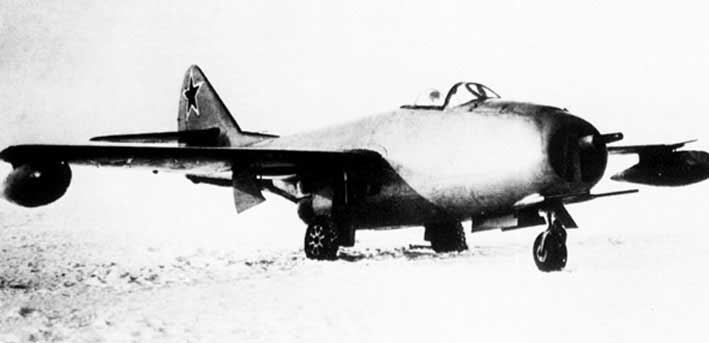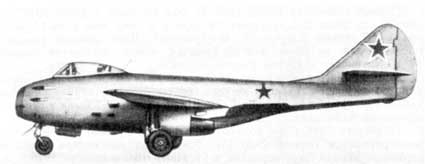

History:
|
In February 1945 Stalin had introduced a crash program to build fighters using turbojet engines, as there were no Soviet made turbojet engines ready at the time the decision was made to use the German Junkers Jumo 004 and the BMW 003 which would be made in the Soviet Union as soon as possible. The I-300 (Mig 9) was the first solely jet powered aircraft made by the Mikoyan/Gurevich bureau, the aircraft it's self was based on a design study "Aircraft F" (with two Lyulka TR-1 engines) but this was reworked to accommodate the two German made BMW 003 engines the bureau had "decided" to use for the new fighter's power output needs. The first flight was on 24/4/1946 piloted by A.N. Grintchik, making the I-300 the first Soviet jet powered aircraft to fly. However the I-300 suffered from very poor performance and evil handling, which were never fully over come. But it entered service as the Mig-9 (I-301) because of political considerations. |
 The I-308 (Mig-9M) |
A major redesign in 1947 resulted in the I-308 (Mig-9M) which was an excellent aircraft, overcoming the I-300's problems and intended to replace the Mig-9 in 1948, but this plan was abandoned because of the new I-310 (Mig-15). Overall 604 Mig-9s of all types were made by the time production was ended in early 1949, including a number of one off's such as I-302 fitted with a single Lyulka TR-1 engine and the Mig-9L, built with a second cockpit for an engineer to test the KS-1 cruise missile. |
|
Before the Mig I-300 took to the air a need for a dual seat trainer version was noted and the I-301T was the outcome. A new seat was fitted in the space occupied by the forward fuel tank, being covered by a new canopy which was much taller than the single seat fighter, the I-301Ts first flight was in July 1947. It had the distinction of being the first Soviet aircraft to use an ejection seat, which was fitted in the rear cockpit. |

|